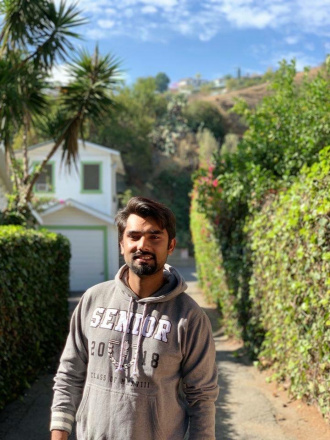Ali Hassan Khan: His RIBES Story
Ali Hassan Khan was the first Early Stage Researcher recruited to the RIBES European Training Network. He works at the centre for Biorobotics in the Environmental Sensing and Intelligence group at Tallin Technical University, and his objectives are to create high-resolution CFD models of full-scale replicas of eight different fish species. These models will aid in investigating how different fish body shapes impact their sensing extent. Here he tells about his background, and his research and expectations within RIBES.

My name is Ali Hassan Khan, and I am a young researcher in the field of computational science and engineering. I was born, raised and completed my primary education in Pakistan, where I attended the University of Wah and received a BSc in Mechanical Engineering. It was during this time that I became introduced to fluid dynamics, which started my journey to Europe. I completed my MSc in the field of Computational science and Engineering from University of Rostock, Germany in 2019 on the topic of ‘‘Numerical investigation of two-phase flow in a coolant tank with OpenFOAM’’. During my MSc studies, I carried out numerical simulations of 3D, multiphase turbulent flows. After my MSc, it became clear to me that there was still much to learn, and doing a PhD would be the best way to do it. I began the search for an interesting and challenging research position in computational fluid mechanics, with a focus on environmental science because I believe that the cutting-edge of computational fluid dynamics (CFD) lies in its application to natural systems, which remain largely unexplored. I found the MSCA RIBES ITN CFD topics extremely interesting, as they are highly multidisciplinary and theoretically very challenging. After rigorous interviews and testing, I am proud to be the RIBES ESR representing the Tallinn University of Technology.
I work at the Centre for Biorobotics in the Environmental Sensing and Intelligence group, led by Dr. Jeffrey Tuhtan and I am co-supervised by TalTech Vice-Rector of Research Prof. Maarja Kruusmaa as well as Dr. Stefan Hoerner from Otto von Guericke University Magdeburg. It is a very diverse lab, and our team fuses the best of electronics, fluid mechanics, biological kinematics, computer systems engineering and environmental modelling. My objective is to create high-resolution CFD models of full-scale replicas of eight different fish species. These models will aid in investigating how different fish body shapes impact their sensing extent. I am going to test these new fish sensors in a very large flume, thanks to the support of Prof. Boris Lehmann from University of Darmstadt. We are going to use this information to build “hydrodynamic antennas” which can be used for many purposes, including improving the navigation of underwater robots. I look forward to working with Prof. Dr. Vladimir Nikora (UNIBD UK) and Viktor Hebrand (FVT Sweden) during my RIBES secondments, where I will learn about fish tracking and flow measurement techniques.
During this 3-year PhD of research work, I look forward to learn about the fish that how do they sense the world around them. The field measurements and CFD models of different fish species will contribute substantially towards our knowledge in understanding the fish hydrodynamics and their sensing abilities, which are essential for their survival in the wild. Working together with my international colleagues in the RIBES ITN, we will undoubtedly discover new findings and provide fresh insights into rivers, fish and flows across Europe. RIBES provides us with the opportunity to become the multidisciplinary generation of eco-hydraulic engineers, ecologists and biologists needed to face the urgent challenges ahead.
